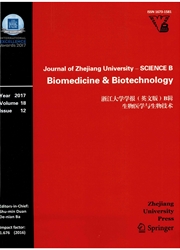

 中文摘要:
中文摘要:
多不的芳香的烃(哼) 是在市政的稳固的浪费(MSW ) 的普通沾染物 composting 地点。在微生物引起的结构的变化的知识是有用的识别详细规格哼 degraders。然而,在 MSW composting 土壤的微生物引起的社区和它的变化与延长暴露联系了到哼并且大部分未知的随后的 biodegradation 遗体。在这研究,蒽作为模型混合物被选择。细菌的社区结构用终端限制碎片长度多型性(TRFLP ) 和 16S rRNA 基因克隆图书馆分析被调查。二个双分子的工具在蒽改正和随后的 biodegradation 以后揭示了细菌的社区结构的大移动。类 Methylophilus, Mesorhizobium,和 Terrimonas 有潜在的连接到蒽 biodegradation,建议起一个活跃作用的一个协会。
 英文摘要:
英文摘要:
Polycyclic aromatic hydrocarbons(PAHs) are common contaminants in a municipal solid waste(MSW) composting site.Knowledge of changes in microbial structure is useful to identify particular PAH degraders.However,the microbial community in the MSW composting soil and its change associated with prolonged exposure to PAHs and subsequent biodegradation remain largely unknown.In this study,anthracene was selected as a model compound.The bacterial community structure was investigated using terminal restriction fragment length polymorphism(TRFLP) and 16S rRNA gene clone library analysis.The two bimolecular tools revealed a large shift of bacterial community structure after anthracene amendment and subsequent biodegradation.Genera Methylophilus,Mesorhizobium,and Terrimonas had potential links to anthracene biodegradation,suggesting a consortium playing an active role.
 同期刊论文项目
同期刊论文项目
 同项目期刊论文
同项目期刊论文
 Anthracene biodegradation under nitrate-reducing condition and associated microbial community change
Anthracene biodegradation under nitrate-reducing condition and associated microbial community change Microbial community changes in aquifer sediment microcosm for anaerobic anthracene biodegradation un
Microbial community changes in aquifer sediment microcosm for anaerobic anthracene biodegradation un Identification of anthracene degraders in leachate-contaminated aquifer using stable isotope probing
Identification of anthracene degraders in leachate-contaminated aquifer using stable isotope probing Molecular characterization of phenanthrene-degrading methanogenic communities in leachate-contaminat
Molecular characterization of phenanthrene-degrading methanogenic communities in leachate-contaminat 期刊信息
期刊信息
